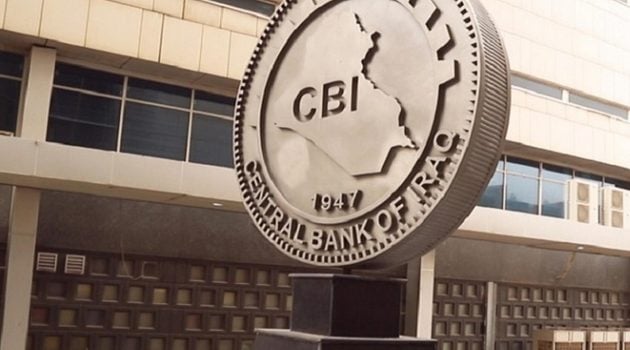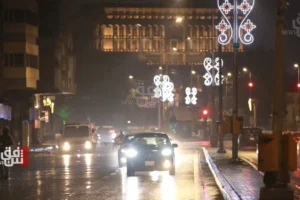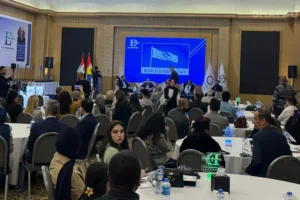
By John Lee.
The Central Bank of Iraq (CBI) has issued a statement setting out its criteria for trading and replacing banknotes.
This unofficial translation is provided in good faith for general information only. While every effort has been made to ensure accuracy, Iraq Business News accepts no responsibility for any errors, omissions, or misinterpretations.
Instructions and Standards for Trading and Exchanging Banknotes and Counting and Sorting Mechanisms
The Central Bank of Iraq, pursuant to its Law No. 56 of 2004 as amended, is responsible for determining the denominations of Iraqi currency (paper and metallic), their specifications and designs, printing paper banknotes and minting metallic coins. It is also responsible for their destruction and replacement, determining defective notes, and has the authority to refuse to exchange such currency (paper and metallic) or to confiscate it if the circumstances set forth in these instructions are met. Iraqi banknotes are homogeneous in all their denominations, have absolute legal tender status, and are accepted by the Central Bank of Iraq and its branches, banks, institutions and the public. Discrimination between denominations by imposing a specific denomination on the public or refusing to accept a specific denomination is unacceptable and is considered contrary to law. We request all banks to comply with the instructions and standards for trading and exchanging banknotes and the counting and sorting mechanisms as set out below:
1. Standards for Trading Banknotes:
A- Banknotes Fit for Circulation
A banknote issued by the Central Bank of Iraq remains fit for circulation if it has been subject to any of the following:
Firstly: If it has sustained one or more tears not exceeding 3 cm that have been repaired with transparent adhesive tape on one or both sides and this has not affected its features.
Secondly: If it has sustained a cut in one of its corners within 2 cm and this has not affected its features.
Thirdly: If it shows signs of circulation and use, and has not sustained damage or harm affecting its appearance, colour or size.
B- Banknotes Not Fit for Circulation
Firstly: Banknotes are deemed not fit for circulation if one of the descriptions listed below applies to them, and their holders shall be compensated for their full value [with the exception of damaged notes specified in paragraph (1/b/Secondly/3)] immediately upon presentation to government and private banks and their branches. Banks shall subsequently deposit them with this Bank or one of its branches, and the equivalent amount shall be credited to their accounts without imposing any penalty.
If the banknote is worn or damaged despite not being torn and not having lost parts.
If the banknote consists of two parts (with different numbers) and its area approximates the area of the original banknote and is secured with adhesive tape.
If the banknote is secured with one or more transparent adhesive tapes along its length or width.
If the banknote has cuts in more than one corner.
If the banknote is defectively printed (in terms of design, size, colour, or other security features that the genuine banknote bears).
If it contains stamps or writing that do not affect its external appearance.
If the banknote has lost less than 50% of its area.
Secondly – Banknotes Damaged Due to Burning, Burial or Any Other Cause:
Banknotes damaged due to burning, burial or any other cause not mentioned in paragraph (1/b/Firstly) shall be received by this Bank and its branches exclusively according to the following mechanism:
1. Required Documents:
a) Civil status identification or unified card or departmental identification and residence card with the citizen’s telephone number.
b) Confirmation from a police station or judicial authority in the case of banknotes damaged as a result of gunfire or contaminated with blood due to accidents.
c) Provision of proof of the source of funds as follows:
For amounts exceeding 10,000,000 dinars (ten million dinars) up to 25,000,000 dinars (twenty-five million dinars), presentation of departmental identification if an employee is required, or a salary slip showing the amount of income and length of service, or proof of a source of income commensurate with the amount to be exchanged. A tradesman must provide proof of practising his profession through a professional practice licence from the relevant sectoral authorities, or a shop lease contract, or production vehicle registration, and other proof of a source of income commensurate with the amount.
For amounts exceeding 25,000,000 dinars (twenty-five million dinars) up to 100,000,000 dinars (one hundred million dinars), presentation of property ownership documents, shares, sales contracts or any official documents proving the legitimacy of the source of such funds (company ownership deed, partnership or contracting or supply contract) commensurate with the submitted amount is required.
2. In the event of dissatisfaction with the required documents submitted due to their lack of authenticity or their disproportionality to the submitted amount, the applicant shall be referred to the Legal Department for the purpose of providing a written undertaking whereby he assumes legal and criminal responsibility for the accuracy of the information provided and that such funds came from legitimate sources and are not connected with any illegal work or suspicious operations.
3. A penalty of 10% of the value of the damaged banknotes shall be levied in favour of this Bank due to their damage resulting from misuse, burial, burning, or any other cause, with the exception of banknotes damaged due to circulation as detailed in paragraph (1/b/Firstly), which shall be exchanged without imposing a penalty.
4. In the event that it is not possible to count the damaged banknotes, they shall be estimated by a committee formed for this purpose, and the committee shall issue its decision within fifteen working days.
2- Confiscation of Damaged Banknotes:
Damaged banknotes not fit for circulation as described below shall be confiscated, and their holder or the party that submitted them shall be notified of the confiscation decision. Anyone whose banknotes have been refused and confiscated has the right to submit a request to the Governor or his delegate through the Director General of Issue and Treasury or the Director General of the Bank Branch to reconsider the decision, and the decision of the Governor or his delegate shall be final:
If changes have been made to the external appearance of the banknote as a result of writing, drawing, printing, stamps or containing adhesive material.
If the banknote has lost 50% or more of its area or consists of two parts with one side, and in the event that there is evidence convincing the Central Bank that the missing parts of the notes have been completely destroyed, partial or full compensation shall be provided for them.
3- Confiscation of Counterfeit and Perforated Notes:
a) Counterfeit notes shall be confiscated and whoever possessed them shall be provided with a receipt confirming receipt of such notes by the cashier or a designated employee at the Central Bank of Iraq and its branches and all banks and their branches, and the details (number of counterfeit notes, their denominations, the name of the depositing customer in whose deposits they appeared and his account number) shall be recorded in a register by the cashier.
b) Confiscated counterfeit notes shall be stamped with the counterfeit stamp bearing the name of the bank and branch and sent to the Central Bank by official letter containing the information in paragraph (a) above.
c) Banks must act in accordance with our letter numbered (9/4/551) dated 1/12/2024 in the event of discovering counterfeit notes.
d) A banknote if changes have been made to it to make its appearance similar to a genuine note by placing or joining different parts of counterfeit or non-conforming currency.
e) Banknotes perforated with four holes in a single banknote that leaked from cancelled banknotes prepared for destruction in our (Mosul) branch after its occupation by terrorist gangs in 2014, where the holes were sealed for the purpose of circulating them as shown in Annex No. (1), shall be confiscated. The banking system must confiscate them and deliver them to the Central Bank of Iraq.
4- Counting and Sorting Mechanisms:
a) Banks must prepare counting and sorting centres with an area commensurate with the volume of their deposits, and must seek to acquire modern machinery and update it continuously to ensure the counting and sorting of banknotes received from their customers, whilst employing qualified workers to do so, provided that we are supplied with the numbers and types of machines used at the head office and its branches.
b) Banks shall send their cash deposits to the vaults of this Bank and its branches after counting and sorting them and separating the damaged ones in bags bundled of good quality and sealed using sewing machines designated for sewing bags, and an additional strip shall be placed during sewing to increase the strength of the bag, with adhesive tape of a colour matching the colour of the denomination bundled inside the bag, and an identification card placed on the bag describing its contents of banknotes, the name of the bank, the type of denomination, and the name of the person who bundled the bag, with the deposit date included either on (the bag or the identification card). It is preferable to fill each bag with the name of one cashier containing (40) bundles, each bundle (1,000 notes) securely tied on both sides by machines designated for this purpose, each bundle containing (10 packets), each packet containing (100 notes) with two identification cards in the first (100) notes and the last (100) notes stamped with a stamp bearing the name of the bank, the three-part name of one cashier, the type of denomination and the date. In the event that there is more than one cashier’s name in one bag or identification papers not belonging to the depositing bank, discrepancies shall be recorded against the bank.
c) The name of a cashier cannot be determined for discrepancies discovered in the bank’s deposits if the counting and sorting operations in this Bank were carried out through comprehensive machines, and the discrepancies shall be recorded against the bank.
d) One bag (40 bundles) shall be filled in two patterns as follows:
Firstly: Denominations (250, 500, 1,000, 50,000) dinars shall be vertically (7) bundles for five rows, making their number (35) bundles. As for the remaining five bundles, two of them shall be horizontally from the sides and the remaining three in the middle vertically, making the number (40) bundles.
Secondly: Denominations (5,000, 10,000, 25,000) dinars shall have a base of (4) bundles horizontally in two rows and a height of (10) bundles to make the total bundles in the bag (40) bundles.
e) For organisational purposes, banks must commit to notifying the Central Bank of the date and amount of deposits in both currencies (local and foreign).
f) Banks must open windows for exchanging damaged and defective banknotes for the public, and announce this through identification boards and advertisements, organise a special register for damaged currency, and deliver it to this Bank and its branches, promote circulation with banknotes of small denominations, and supply all bank branches with them.
g) Banks shall deposit damaged banknotes received from their customers or from the general public for any quantity, even if it is a single banknote, provided they are well sorted and actually damaged, and sent with letters explaining their condition and amounts according to a delivery timetable to be determined by the Issue and Treasury Department. In the event that there are banknotes fit for circulation in your damaged deposits and in large quantities, this is considered a banking violation for which the bank shall be held accountable.
h) Authorised persons to review this Bank/Issue and Treasury Department shall be nominated through the electronic platform designated for this purpose, as well as the names of workers used by the bank to transport cash deposits into this Bank, their addresses and identity documents, provided they carry identification badges specific to the bank. Otherwise, the bank shall bear legal responsibility.
i) Correspondence with this Bank shall be signed by the Director General for government banks and the authorised director for private banks and the regional director for foreign branches or their deputies in their absence.
5- Mechanism for Counting and Sorting Banknotes at the Central Bank of Iraq:
a) Penalties imposed on discrepancies discovered in your deposits of Iraqi banknotes shall be calculated as follows:
Firstly: Any surplus discovered in the bank’s deposits shall be credited to its current account.
Secondly: Any shortage discovered in the bank’s deposits shall be debited to its current account and a penalty shall be imposed in the manner determined by the Bank on the value of the banknotes (shortage), and the penalty rate has currently been set at (100%) of the value of the banknotes with compensation for the shortage from its account.
b) In the event of discovering counterfeit notes within the bank’s deposits (whether conforming to or different from the declared denomination), they shall be confiscated and recorded as a shortage in both cases (surplus or shortage of 100 notes), and the penalty rate shall be recorded in the manner determined by the Bank. The penalty rate has currently been set at (500%) of the value of the discovered counterfeit notes with compensation for the shortage from the bank’s account.
c) When Iraqi banknotes appear that differ from the declared banknotes, their number shall be recorded as a shortage in both cases (surplus or shortage of 100 notes) with imposition of a shortage penalty of (100%), and the (different denomination) notes discovered in the bank’s deposits shall be credited to its current account.
Fifthly: When non-Iraqi currency denominations appear, they shall be delivered to the bank’s authorised representative and recorded as a shortage in both cases (surplus or shortage of 100 notes) with imposition of a shortage penalty of (100%) of the declared denomination.
Sixthly: Banknotes perforated with four holes referred to in paragraph (3/e) discovered within the bank’s deposits shall be confiscated and recorded as a shortage in both cases (surplus or shortage of 100 notes), with imposition of a shortage penalty as in paragraph (5/a-Secondly).
b) The bank has the right to object to the counting and sorting results within one week from the date of being notified of the results, and the bank’s authorised representative is permitted to view the video recording taken by surveillance cameras of the process of opening the bank’s bags.
c) Official correspondence and communication shall be with the Banks Follow-up and Reconciliation Section, and results of counting and sorting operations and copies of cashiers’ identification papers shall be sent via email ([email protected]). Identification papers shall be destroyed after seven days from notifying the bank of discrepancies, and the bank shall not have the right to claim them.
d) Receipt and delivery of deposits or withdrawals of banknotes in both currencies (local and foreign) shall be during official working hours, currently set from (8:30 – 2:00), and no vehicles or persons affiliated with banks shall be permitted to enter outside these times. These deposits and withdrawals must be transported by armoured vehicles from or to this Bank. In the event that your deposits are delayed beyond the times mentioned above for reasons convincing to the management of this Bank and its branches, such deposits may be received as a trust for a period not exceeding one working day by means of a trust deposit form, provided that the received amounts are bundled and sealed with the bank’s seal in a manner ensuring they cannot be opened except in the presence of its authorised representative on the morning of the following working day for the purpose of withdrawing the trust and conducting the initial examination.
e) The responsibility of the Central Bank of Iraq and any bank or cashier or any person is at the point at which the banknotes leave their possession, and it is assumed that the person receiving the banknotes should not leave the receipt point before confirming the amount. The recipient of banknotes from this Bank may request to carry out counting operations himself and with whomever he wishes from the personnel of his department, under the supervision of Central Bank staff, including the provision and preparation of all counting requirements including counting and bundling machines. After completing the counting process, the bank becomes responsible for the banknotes it pays even if they bear identification cards of the parties from which they were received.
f) In the event that the bank discovers an error in its deposits (surplus or shortage) before conducting the counting and sorting operation for those deposits, it must notify the Issue and Treasury Department at the end of the deposit day or at the beginning of the following day by sending an official letter specifying the error amount and type of denomination precisely. After the counting and sorting operations for those deposits, confirmation shall be made of the conformity of the difference amount with what is mentioned in the bank’s letter in the presence of the authorised representative, and compensation for the shortage from the bank without imposing a penalty or delivery of the surplus, if any, by official report.
g) In the event that a bank retains identification cards belonging to the Central Bank or another bank and includes them in its deposits and releases them for circulation in that manner, this is considered a violation for which the bank shall be held accountable.
6- Foreign Currency Banknotes
a) Cash Deposits: This Bank receives deposits of foreign currency banknotes subject to counting and sorting fees for all denominations and all issues according to the mechanism set out below:
Firstly: Compliance with the official deposit times mentioned in paragraph (5/d).
Secondly: Sending an official letter to this Bank authorising the bank’s employees to deposit foreign currency banknotes by means of a deposit slip showing the details of the amount and stamped with the bank’s seal, the name of the authorised representative and his signature.
Thirdly: Sending an electronic memory device containing the numbers of the deposited banknotes with a paper list of numbers for each (100) notes, and in the event of non-conformity of numbers, the numbers recorded by the Bank shall be adopted.
Fourthly: Banks shall send their foreign cash deposits (dollars and euros) after counting and sorting them and packing them according to currency denominations to the vaults of the Central Bank of Iraq and packing them in good quality bags (thick nylon). One bag shall contain (10) bundles (ten bundles) as a maximum, each bundle containing (1,000) notes (one thousand notes) tied securely, distributed into (10) batches (ten batches), each batch containing (100) notes (one hundred notes) bundled in nylon bags and sealed by heat sealing or sewing them with the designated machine after adding a strip to increase the strength of the bag, and placing an identification card on the bag describing its contents of banknotes, the name of the bank, the type of denomination and the deposit date, with inclusion of the name of the person who bundled the bag.
Fifthly: Foreign currency banknotes deposited shall be counted and sorted on the same day, and in the event of discrepancies, the bank’s authorised representative shall compensate directly. In the event that counting and sorting them on the same day is not possible, they shall be deposited in the foreign currency vault pending counting and sorting, and the work date shall be determined later.
Sixthly: Counterfeit foreign notes (dollars and euros) shall be confiscated with compensation for the shortage by the bank’s authorised representative.
Seventhly: In the event of a shortage within deposits of foreign currency banknotes (dollars and euros), it shall be compensated by the bank’s authorised representative.
Eighthly: When a surplus appears in foreign currency banknotes, it shall be delivered to the bank’s authorised representative by means of a receipt of receipt.
Ninthly: When foreign currency banknotes appear that differ from the declared banknotes, they shall be replaced with the same denomination and any shortage compensated through the authorised representative.
Tenthly: One bag shall be filled by placing two bundles horizontally in two rows, making the number of bundles (8) bundles. As for the last two bundles, they shall be vertically for the third row, making the number (10) bundles.
Eleventhly: When damaged foreign cash deposits appear within the bank’s deposits and are rejected by the counting and sorting machines, the bank shall have the option of compensating for the number of notes or this Bank exchanging them through the Federal Bank, provided the bank bears the exchange cost.
Twelfthly: The bank shall be provided with a confirmation receipt in the event that the accounting entry cannot be made, and they may be received as a trust as in paragraph (5/d).
b) Cash Payments:
Firstly: Cash payments through the foreign currency sale and purchase window:
Providing the bank with a written undertaking upon receipt of the participation amount in the foreign currency sale and purchase window obliging it to distribute the share of the companies participating with it according to the electronic distribution of this Bank and sending the undertaking within (48) hours.
Secondly – Cash Payments from the Bank’s Balance with this Bank:
The bank shall commit to submitting tables in Excel format with the numbers of foreign currency banknotes received distributed to the final beneficiary in instalments or a single instalment, and in the event that it does not distribute all or part of the amount, we shall be informed by official letter showing the amount remaining within its vaults.
The bank may not submit more than one request to withdraw the amount in one day.
c) Criteria relied upon in rejecting foreign currency banknotes (dollars and euros) during counting and sorting operations if one of the descriptions listed in detail below applies to them:
Firstly: If it has sustained a cut in one of its corners or was torn or has lost any part of the note area.
Secondly: If it has sustained a tear and has been repaired with transparent adhesive tape from any side.
Thirdly: If it contains a large stamp or several small stamps that affect its features.
Fourthly: If it shows signs of circulation and use (worn) that affect its appearance or features.
Fifthly: If foreign materials have adhered to it and affected its features such as inks, dyes, glues, ground, cooked or paste materials, fats or oils.
Sixthly: If it has been stored in incorrect storage conditions leading to it yellowing or emitting a musty smell.
7- Mechanism for Transporting Cash Deposits
All banks must use armoured vehicles belonging to them or to entities specialised in transporting funds for the purpose of transporting cash deposits from and to this Bank and between banks, and provide us with the types and numbers of armoured vehicles or the entity responsible for transport.
8- Compliance with the Instructions Set Out Above
In the event that banks do not comply with the applicable instructions and banking violations are repeated and there is no response to our letters when requested, the Issue and Treasury Department shall recommend referring the violating bank to the Committee for Determining Penalties Imposed on Banks and Non-Banking Financial Institutions in accordance with the Central Bank of Iraq Law.
9 – The aforementioned instructions shall come into force from the date of issuing the letter and shall replace all our previous letters and circulars in this regard.
See also:
CBI to Support Dinar Stability
Dinar Page
(Source: Central Bank of Iraq)





